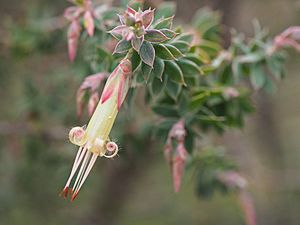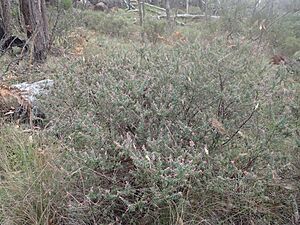Montane green five-corners facts for kids
Quick facts for kids Montane green five-corners |
|
|---|---|
 |
|
| Leaves and flower of Styphelia perileuca | |
| Conservation status | |
| Scientific classification | |
| Genus: |
Styphelia
|
| Species: |
perileuca
|
The Styphelia perileuca, also known as montane green five-corners, is a special plant. It belongs to the heath family, called Ericaceae, and grows only in New South Wales, Australia. This plant is a shrub that stands tall and spreads out. It has wide leaves with a pointy tip. Its flowers are shaped like tubes and are yellowish-green with red colors. The tips of the petals are rolled back.
This unique plant is only found in a small area on the eastern edge of the New England Tableland.
Contents
What Does Montane Green Five-Corners Look Like?
Styphelia perileuca is a shrub that can grow up to about 3 feet (1 meter) tall and wide. Its leaves are usually oval-shaped. They are about 6 to 12 millimeters (0.2 to 0.5 inches) long and 3 to 5 millimeters (0.1 to 0.2 inches) wide. The leaves are slightly curved like a dish, with tiny teeth along their edges and a sharp point at the tip.
The flowers are tube-shaped and are yellowish-green with thin red stripes. They hang by themselves from where the leaves meet the stem. Each flower has five sepals (leaf-like parts that protect the bud) that are about 9 to 10 millimeters (0.35 to 0.39 inches) long and smooth. The five petals are joined together, forming a tube about 12 to 14 millimeters (0.5 to 0.6 inches) long. The tips of these petals roll back and are hairy on the inside. The stamens, which are the parts that hold pollen, are straight and stick out past the end of the petal tube.
This plant usually flowers between September and January. However, you might also see flowers in April.
How Was This Plant Named?
The plant Styphelia perileuca was officially described in 1992 by a scientist named Jocelyn Powell. Her description was published in a science journal called Telopea.
The second part of its scientific name, perileuca, comes from two ancient Greek words. Peri means "around," and leukos means "white." This name refers to the thin white edge that you can see around the leaves of the plant.
Where Does Montane Green Five-Corners Grow?
The montane green five-corners plant is only found in a few specific places. These include Cathedral Rock National Park, New England National Park, and an area near Maclean. It likes to grow in shrubland areas close to swamps and also in forests.
Why Is This Plant Important to Protect?
The Australian Government has listed Styphelia perileuca as "vulnerable." This means it is at risk of becoming extinct if we don't protect it. This classification is under a law called the Environment Protection and Biodiversity Conservation Act 1999.
The main reasons why this plant is vulnerable are:
- It has a very small population, meaning there aren't many of these plants left.
- It grows in only a few specific places, so its habitat is very limited.
Protecting these areas helps ensure that the montane green five-corners can continue to grow and thrive.



